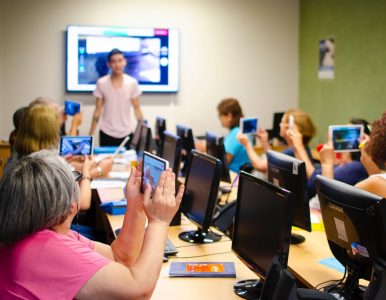+Simple, digital inclusion for older people



Within the framework of the Technology Inclusion Program, we delivered 106,550 tablets with the “+ Simple” platform to people over 60 years of age.
The platform groups content such as news, procedures, and social networks, as well as providing access to pages of interest. At the same time, older people were trained in the use of this tool through a 2-hour course. Finally, based on the needs transmitted by the beneficiaries, we incorporated new contents and applications.
The aim is to promote their social inclusion through a complete digital literacy process. A first registration stage was carried out, followed by the draw and delivery to beneficiaries. We opened 40 Digital Classrooms accessible and with Internet, where they are scheduled and trained daily. More than 20 people have the role of trainer and teach in the classrooms. For the first delivery, the National Communications Agency (ENACOM) participated, and in the second delivery we had the EXO company. For the development of the platform was the company INAMIKA. Retirement Centers, and other private institutions provide us with space, through agreements, for the delivery of courses.
We managed to meet the target of total tablet delivery by 2018, and we exceeded 50% of trained beneficiaries. We cover all the communes of the City with the open Digital Classrooms. Thus, each beneficiary has a nearby classroom to learn how to use the Tablet. Throughout the program, we learned the importance of constant and fluid communication with older people to detect unmet needs, as well as new difficulties, and on that basis carry out improvements in the literacy process.
The “+ Simple” program seeks to narrow the existing digital gap among older adults, and reach technology to the most vulnerable sectors within that age range. The program has a constant process of opening and replacing digital classrooms, in order to improve educational conditions; as well as implementation of improvements to the digital tool. In the short term we seek to bring the platform to both mobile and web, to expand access to all elderly people living in the City.
Finally we incorporated “+ Simple Community”, an application that seeks to approach older adults through the creation and participation of events, as well as offering the possibility of finding love.
Within our website, you can find tutorials, news, and details of the contents of the platform:
http://www.buenosaires.gob.ar/desarrollohumanoyhabitat/personasmayores/massimple
Website: https://www.facebook.com/MasSimpleGCBA/
Main target group: Vulnerable older people (e.g. at risk or victims of abuse, living alone, poor etc.)
Other target group(s): It sought to reach digitally more vulnerable older adults. That is, those who, by socioeconomic level, are less likely to have access to technology. For this, both in the registration and in the draw, conditions were established regarding the economic income of the possible beneficiaries.
Sector(s): Education, Information and communication, Other
Desired outcome for older people:
Learn, grow and make decisions